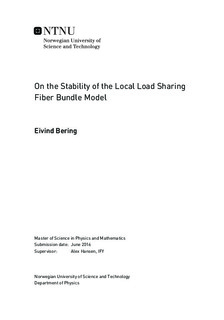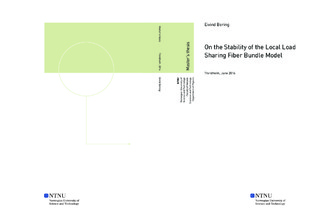| dc.description.abstract | This thesis investigates a generalized history-independent local load sharing (LLS) fiber bundle model for two dimensional interfacial fractures. When the failure threshold of the fibers are assigned according to the cumulative distribution
P(x)=1-e^{-x+x_0},
the model displays two distinct regimes separated by a critical transition. For systems with low cutoff x_0, the damage is developing through random weakening of the system, which resembles the equal load sharing (ELS) model. As the cutoff is increased, the behaviour approaches invasion percolation. This localization transition is determined to occur at the critical cutoff
x_c=0.6173 ± 0.0005,
with a critical exponent
beta / nu = 1.5 ± 0.1.
The LLS model displays a local stability not seen in the ELS model. By estimating the cutoffs that results in the highest positive slope in the strain curve for a range of lattice sizes, extrapolation to the thermodynamic limit reveals a cutoff that coincides with the critical cutoff, with a correlation length exponent
nu = 2.
This stability originates in the short-range interaction of the model, which effectively stresses the strong fibers the most. Moreover, the LLS model is shown to be globally more stable than the ELS model when x_0 is approximately less than 0.5. The global stability of the LLS model vanishes around the critical transition. This is related to a change in the distribution of bursts, i.e. the fibers that fails consecutively. For the LLS model, the burst distribution is shown to be consistent with a power law D (delta) ~ delta^{-tau}, with burst exponent
tau=2
around the critical transition. Analog to the criticality of the ELS model at x_0=1, lower cutoffs results in higher burst exponents, and cutoffs above x_c gives rise to exponential decay in the burst distribution. The distribution of fatal bursts, which cause the entire bundle to rapture, reveals a drastic change of behaviour around the critical transition. For cutoffs above x_c, far fewer fibers may break before the bundle would undergo catastrophic failure in a force controlled experiment. | |

